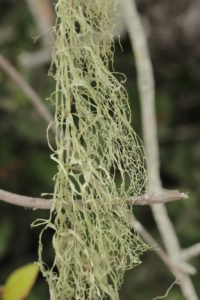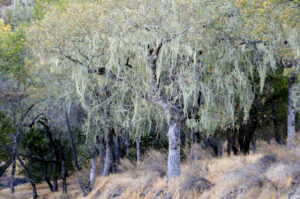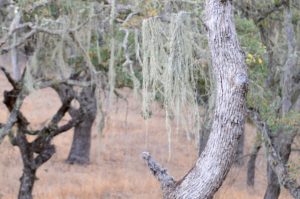Ramalina menziesii
Description and Habitat
Like other lichens, the lace lichen is a combination of fungi and algae (or cyanobacteria). They are great example of symbiosis in the natural world. The fungal component of a lichen helps obtain water and nutrients while the algal component uses photosynthesis to create food. Each organism benefits from this relationship. Interestingly, lichens’ scientific names are based on the particular fungus associated with them.
This plant can grow up to one meter in length and can be found in western North America ranging from Baja California to Southern Alaska. Almost non-existent in drier areas within this range, lace lichen is most likely to be found on damp slopes facing the coast. The specific location of the lace lichen displays a clear preference for a more temperate climate with periodic moisture.
Lace lichen is identifiable by its flat, yellowish-green branches that often form large clumps whilst hanging from trees. It is often mistaken for Spanish moss, which is found in the eastern and southern United States and is neither a moss nor a lichen.
Ecological Importance and Uses
Lace lichen is a staple in the diet of mule deer and an integral part of the nesting materials used by various birds. It is also being studied for its antibacterial properties. Humans have found great use for the species’ sensitivity to air pollution and climate change by using it to monitor air quality. The lichen’s sensitivity to sulfur dioxide in addition to many other pollutants allows for the plant to signal reductions in atmospheric pollution.
On July 25, 2015 Governor Jerry Brown signed a bill into law that would officially recognize the lace lichen as the California State Lichen. This law became effective on January 1, 2016. California is the only state to have a recognized state lichen.
Lace Lichen in the Los Padres
You can find this lichen hanging from various types of oaks throughout the coastal mountains of the Los Padres National Forest. On and around Figueroa Mountain is an excellent place to spot lace lichen growing in the branches of valley, blue, and coast live oaks. You can also find it along Paradise Road within the national forest just north of Santa Barbara. Further north, areas near San Luis Obispo such as Huasna Road or Upper Lopez Canyon Road provide many opportunities to see this unique lichen.









